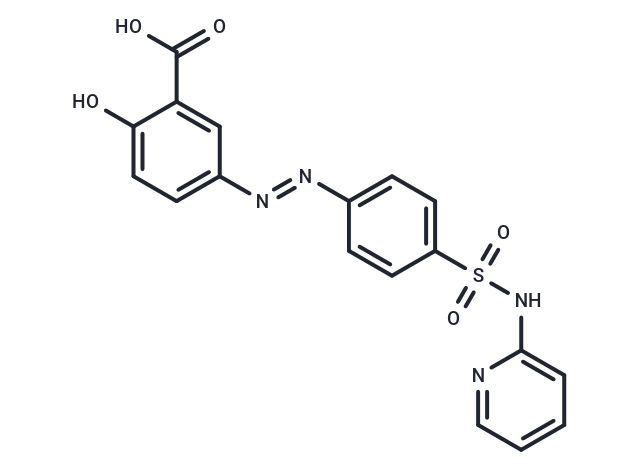Shopping Cart
Remove All Your shopping cart is currently empty
Your shopping cart is currently empty
Sulfasalazine (Azulfidine) is a synthetic salicylic acid derivative with affinity for elastin-containing connective tissues and formulated as a prodrug. Sulfasalazine induces iron death and inhibits NF-κB, TGF-β and COX-2.

| Pack Size | Price | USA Warehouse | Global Warehouse | Quantity |
|---|---|---|---|---|
| 200 mg | $30 | In Stock | In Stock | |
| 500 mg | $44 | In Stock | In Stock | |
| 1 g | $53 | In Stock | In Stock | |
| 5 g | $86 | - | In Stock | |
| 10 g | $98 | - | In Stock | |
| 1 mL x 10 mM (in DMSO) | $48 | In Stock | In Stock |
| Description | Sulfasalazine (Azulfidine) is a synthetic salicylic acid derivative with affinity for elastin-containing connective tissues and formulated as a prodrug. Sulfasalazine induces iron death and inhibits NF-κB, TGF-β and COX-2. |
| Targets&IC50 | Synthesis of leukotriene C4:100 μM, contractile leukotriene activity:0.15 mM, Synthesis of 5-hydroxyeicosatetraenoic acid:250 μM, synthesis of LTB4:2.8 mM (endogenous arachidonic acid is the substrate), synthesis of LTB4:0.8 mM (exogenous arachidonic acid is the substrate), PAF:50 µM, Cystine uptake:24.7 ± 5.6 μM, Synthesis of leukotriene B4:250 μM |
| In vitro | METHODS: Rat glioma cells F98 and human glioma cells U251 were treated with Sulfasalazine (200-400 µM) for 96 h. Cell viability was measured by MTT assay. RESULTS: Cell viability was significantly reduced in F98 at 200-400 µM Sulfasalazine concentration and U251 showed reduced cell viability at 400 µM Sulfasalazine. [1] METHODS: Mouse melanoma cells B16F10 and mouse embryonic fibroblasts MEF were treated with Sulfasalazine (10-1000 µM) for 24 h. Cellular ROS levels were measured by DCFDA staining. RESULTS: At lower Sulfasalazine concentrations (10-100 µM), no increase in intracellular ROS was observed. At higher concentrations of Sulfasalazine (800-1000 µM), there was an approximately 2.3-fold increase in intracellular ROS in B16F10 cells, while no increase in ROS was observed in MEF cells. [2] |
| In vivo | METHODS: To detect antitumor activity in vivo, Sulfasalazine (250 mg/kg) was administered intraperitoneally to C57BL/6N mice bearing B16F10 xenografts once daily for three days. Twenty-four hours after the third Sulfasalazine dose, local X-ray irradiation was applied to anesthetized tumor-bearing C57BL/6N mice at a dose of 4 Gy. RESULTS: Sulfasalazine alone did not significantly inhibit tumor growth; X-ray irradiation partially reduced tumor growth; the combination of Sulfasalazine and X-rays synergistically reduced tumor growth. [2] |
| Cell Research | Sulfasalazine is dissolved in culture medium. SW620 cells are grown in Dulbecco's modified Eagle medium, supplemented with 10% heat-inactivated FCS, 2 mmol/liter glutamine, and 1% (wt/vol) penicillin/streptomycin. SW620 cells are transfected with the 3xIgkBLuc reporter construct. After 18 h, cells are incubated with either medium alone or with sulfasalazine (0.1, 0.2, 0.5, 1, 2, 5 mM) before stimulation with TNFα, LPS, or PMA. Luciferase assay is performed[1]. |
| Synonyms | NSC 667219, Azulfidine |
| Molecular Weight | 398.39 |
| Formula | C18H14N4O5S |
| Cas No. | 599-79-1 |
| Smiles | OC(=O)C1=CC(=CC=C1O)\N=N\C1=CC=C(C=C1)S(=O)(=O)NC1=CC=CC=N1 |
| Relative Density. | 1.3742 g/cm3 (Estimated) |
| Color | Yellow |
| Appearance | Solid |
| Storage | keep away from direct sunlight,keep away from moisture | Powder: -20°C for 3 years | In solvent: -80°C for 1 year | Shipping with blue ice/Shipping at ambient temperature. | |||||||||||||||||||||||||||||||||||
| Solubility Information | NaOH: 250 mg/mL (627.53 mM) DMSO: 200 mg/mL (502.02 mM), Sonication is recommended. | |||||||||||||||||||||||||||||||||||
| In Vivo Formulation | 10% DMSO+40% PEG300+5% Tween 80+45% Saline: 20 mg/mL (50.2 mM), Suspension. Please add the solvents sequentially, clarifying the solution as much as possible before adding the next one. Dissolve by heating and/or sonication if necessary. Working solution is recommended to be prepared and used immediately. The formulation provided above is for reference purposes only. In vivo formulations may vary and should be modified based on specific experimental conditions. | |||||||||||||||||||||||||||||||||||
Solution Preparation Table | ||||||||||||||||||||||||||||||||||||
DMSO/NaOH
| ||||||||||||||||||||||||||||||||||||
| Size | Quantity | Unit Price | Amount | Operation |
|---|

Copyright © 2015-2026 TargetMol Chemicals Inc. All Rights Reserved.